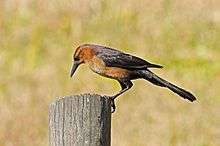Boat-tailed grackle
| Boat-tailed grackle | |
|---|---|
 | |
| Male | |
 | |
| Female | |
| Scientific classification | |
| Kingdom: | Animalia |
| Phylum: | Chordata |
| Class: | Aves |
| Order: | Passeriformes |
| Family: | Icteridae |
| Genus: | Quiscalus |
| Species: | Q. major |
| Binomial name | |
| Quiscalus major Vieillot, 1819 | |
 | |
| Range of Q. major Year-round range Wintering range | |
The boat-tailed grackle (Quiscalus major) is a passerine bird of the family Icteridae found as a permanent resident on the coasts of the southeastern United States. It is found in coastal saltwater marshes, and, in Florida, also on inland waters. The nest is a well-concealed cup in trees or shrubs near water; three to five eggs are laid.
The male boat-tailed grackle is 37–43 cm (15–17 in) long and weighs 165–250 g (5.8–8.8 oz).[2] Adult males have entirely iridescent black plumage, a long dark bill, a pale yellowish or brown iris and a long keel-shaped tail. The adult female is much smaller at 26–33 cm (10–13 in) long and a weight of 90–115 g (3.2–4.1 oz).[3] She is also distinguished by her shorter tail and tawny-brown coloration, which covers the body apart from the darker wings and tail. The wingspan in adult birds is 39–50 cm (15–20 in).[4] In standard measurements, this species measures 13–20 cm (5.1–7.9 in) along the wing bone, 11–20 cm (4.3–7.9 in) in tail length, 2–4.2 cm (0.79–1.65 in) along the culmen and 3.6–5.8 cm (1.4–2.3 in) along the tarsus.[5] On average, the boat-tailed grackle weighs about 10% more than the closely related great-tailed grackle although the male great-tailed grackle has an even longer tail.[5][6]
Young males are black but lack the adult's iridescence. Immature females are duller versions of the adult female and have blotches or spots on the breast. The eye color of the boat-tailed grackle varies with range. Gulf Coast and inland birds have dark eyes, whereas Atlantic birds have pale eyes.[7]
The boat-tailed grackle was first described by French naturalist Louis Jean Pierre Vieillot in 1819. Its specific epithet major means "larger" in Latin. Despite its restricted range, there are four subspecies of the boat-tailed grackle, differing in size and iris color. The boat-tailed grackle was once considered the same species as the great-tailed grackle. The great-tailed species is generally quite similar of slightly smaller body size, but has a longer tail and lacks this species' distinct domed head shape. The common grackle, with which the boat-tailed species often overlaps along the Atlantic coastline, is noticeably smaller and shorter-tailed, as well as lacking the domed head shape.

These birds forage on the ground, in shallow water, or in shrubs; they will steal food from other birds. They are omnivorous, eating insects, minnows, frogs, eggs, berries, seeds, and grain, even small birds.
Boat-tailed grackles have established significant populations in several United States Gulf Coast cities and towns where they can be found foraging in trash bins, dumpsters, and parking lots.
This bird's song is a harsh jeeb, and it has a variety of typically grackle-like chatters and squeaks.
References
- ↑ BirdLife International (2012). "Quiscalus major". IUCN Red List of Threatened Species. Version 2013.2. International Union for Conservation of Nature. Retrieved 26 November 2013.
- ↑ "FieldGuides: Species Detail". eNature. Retrieved 5 March 2013.
- ↑ Bancroft, G.T. (1984). "Growth and sexual dimorphism of the Boat-tailed Grackle" (PDF). Condor. 86 (4): 423–432. doi:10.2307/1366822. JSTOR 1366822.
- ↑ "Boat-tailed Grackle". All About Birds. Cornell Lab of Ornithology. Retrieved 5 March 2013. "Boat-tailed Grackle, Life History, All About Birds – Cornell Lab of Ornithology". Allaboutbirds.org. Retrieved 2013-03-05.
- 1 2 Jaramillo, Alvaro; Burke, Peter (1999). New World Blackbirds: The Icterids. Christopher Helm Publishing. ISBN 978-0713643336.
- ↑ Dunning Jr., John B., ed. (1992). CRC Handbook of Avian Body Masses. CRC Press. ISBN 978-0849342585.
- ↑ "Grackles – Are you getting them right?". eBird.org.
- "Quiscalus major". Integrated Taxonomic Information System. Retrieved 6 February 2006.
External links
| Wikimedia Commons has media related to Quiscalus major. |
| Wikispecies has information related to: Quiscalus major |
- Boat-tailed grackle at Florida Bird Sounds (Florida Museum of Natural History)
- BirdLife species factsheet for Quiscalus major
- "Quiscalus major". Avibase.

- "Boat-tailed grackle media". Internet Bird Collection.
- Boat-tailed grackle photo gallery at VIREO (Drexel University)
- Interactive range map of Quiscalus major at IUCN Red List maps
- Audio recordings of Boat-tailed grackle on Xeno-canto.
